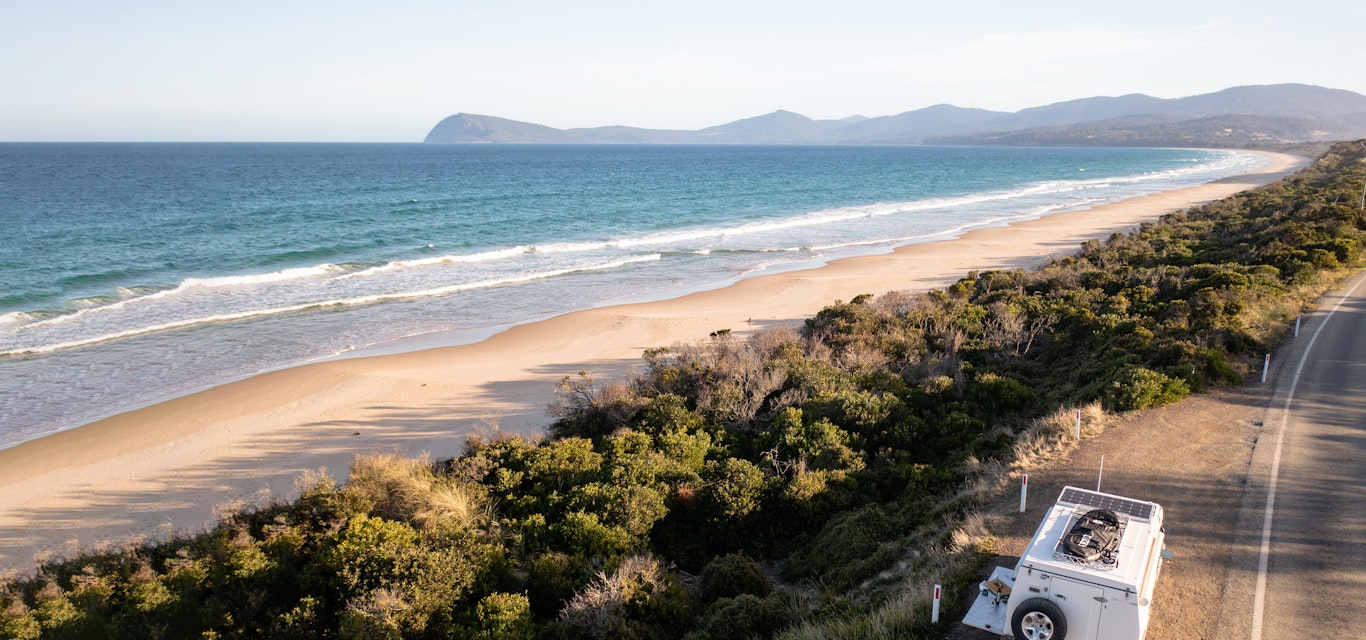Five tow-tally awesome caravan trips in Tassie
Tasmania is blessed with a remarkable concentration of natural wonders accessible by caravan, many within easy reach of Hobart and Launceston. Here, caravanning expert and author Catherine Best rounds up five of the best caravanning destinations.
Freycinet
For the water babies
The jewel of Tasmania’s east coast, Freycinet National Park is a striking montage of ocean-nibbled sandy coves and blushing granite peaks. Caravanners can stay at the campground inside the national park, but sites are small so big vans should opt for the caravan park at nearby Coles Bay.
Wineglass Bay is the park’s main draw, and can be accessed by boat or on foot, together with various other secluded peaks and beaches. For snorkelling, head to Sleepy Bay or Honeymoon Bay, ride the gentle waves at Muirs Beach, or opt for a paddle (SUP or kayak) at sheltered Richardsons Beach, framed by the dramatic Hazards Mountains.
Stanley
For the historic buffs
There’s something about Stanley. The tiny fishing village couldn’t get more photogenic – pinched between the sea and a tabletop mountain, known as the Nut, on an isthmus in north-west Tasmania. Beneath the Nut, a garland of heritage cottages gives the impression a horse-drawn carriage might come clattering past.
The main sights in Stanley, 215km west of Launceston, revolve around the Nut, a volcanic plug you can climb or zip up on the chairlift. North of the Nut, the 1826 Highfield Historic Site is a must visit. The homestead, formerly the headquarters of the Van Diemen’s Land Company, provides a fascinating insight into Tasmania’s early wool traders, as well as a great vantage point of the Nut.
More history can be unravelled in the cottages open to the public along Church St, including Joe Lyons Cottage, birthplace of the only prime minister born in Tasmania. Don’t miss seeing the penguins come ashore at sunset on Godfreys Beach.
Credit: Tourism Tasmania
Credit: Adrian Cook
Bruny Island
For an all-in getaway
How marvellous it is that an island off an island is accessible by caravan, thanks to the SeaLink ferry, departing from Kettering, 32km south of Hobart. Bruny – technically two islands joined by a slender isthmus – is ringed by pearly white beaches, secluded coves and sea cliffs that are among the tallest in Australia. It’s also a gastronomy hotspot, home to boutique producers of craft beer, cold-climate wines and spirits, artisan cheese, chocolate, oysters and berries.
Truganini Lookout at The Neck, where the north and south islands meet, provides wonderful vistas across the island and is frequented by little penguins. Other highlights include the Quarantine Station, Cape Bruny Lighthouse (1838) and cruising past 272m-high cliffs to a seal colony at the southernmost tip of the island with Bruny Island Cruises.
Huon Valley
For the foodie and nature fans
The lush rolling pastures of the Huon Valley are a foodie and nature enthusiast’s paradise, less than an hour from the centre of Hobart. You can comfortably eat your way around the wineries, farm-gates and restaurants, then burn off the extra calories on a walk through the wilderness. Huonville is an excellent springboard for exploring the region’s abundant spoils, starting with Willie Smith’s Apple Shed in Grove, Glen Huon Dairy and the Port Cygnet Cannery. Linger in Franklin, on the banks of the Huon River, visiting the Wooden Boat Centre and Frank’s Ciderhouse and Cafe for a window into the region’s boatbuilding and apple-growing traditions.
For natural attractions, visit Hastings Caves and Thermal Springs, the treetops walk at Tahune Adventures, and the former whaling settlement of Cockle Creek on Australia’s southernmost road, dubbed “the end of the world”.
Credit: Rob Burnett
Cradle Mountain
For the hiking enthusiast
One of Australia’s most celebrated alpine regions, Cradle-Mountain–Lake St Clair National Park is a caravan-friendly wilderness icon. Two million years of glacial erosion and deposition have sculpted a landscape of rugged alpine peaks, lakes, moraines, windswept moors and ancient rainforests. The dolerite spires of Cradle Mountain, towering over Dove Lake, form one of Australia’s most recognisable natural skylines. To see them, you’ll need to enter the park from the northern end, about 140km west of Launceston.
The park has various hikes catering for allabilities – from the short creek-side Enchanted Walk, through forests of myrtle and pencil pine, to the strenuous Cradle Summit. Dove Lake Circuit is a spectacularly scenic trail and mostly flat.
